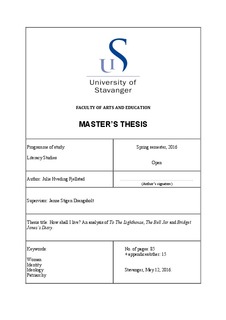| dc.description.abstract | This thesis is a comparative study of the female discourse in three different literary texts, from different periods, with a focus on how they represent and present identity in different ideological contexts. Historically, there have been social norms and implicit rules of what it meant to be a woman and thus, women have felt pressured to conform to these ideals.
Even though women have the same rights as men today in many cultures, there are still issues that need to be addressed.
The present study has conducted close readings and comparative analyses of three texts in order to see how ideology has affected female identity, from early twentieth century and up until contemporary. The textual framework is Virginia Woolf`s To The Lighthouse (1927), Sylvia Plath`s The Bell Jar (1963) and Helen Fielding`s Bridget Jones`s Diary (1996).
Mrs. Ramsay, Lily Briscoe and Esther Greenwood tried to uncover their own self-identities in societies that were extremely patriarchal. In order to see how these texts relate to the contemporary, the character of Bridget Jones has also been included. All three texts from different periods approach the problem with the concept of “woman”, from different perspectives. The Victorian image of the ideal woman or wife came to be known as “the angel in the house”. As the angel, women became an object, only there to be displayed and desired. During the turn of the century, the New Woman emerged as a response to these Victorian ideals. The early women rights movement resulted in a vast number of opportunities for women within work force and education. However, while women gained more rights as a result of the first wave of feminism, the post-war America represented a change in the concept of “woman” as many returned to the domestic sphere. In this ideological setting, young girls and women were taught to be ideal housewives. The maintenance of the house and the care of the family were women´s main priorities. Women resumed to the roles as mothers and wives, which resembled the Victorian ideal. Through the second wave of feminism, these ideals were once again challenged. In the contemporary society women are liberated and free to do what they want. However, even though women today have equal rights, concerning education, politics and the work force, there are still images of “woman” that need to be confronted. All the female characters are trying to search for a self that is not governed by the ideological concept of “woman”. | nb_NO |

